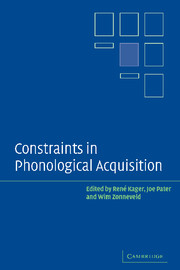Book contents
- Frontmatter
- Contents
- List of contributors
- Abbreviations
- Preface
- 1 Introduction: constraints in phonological acquisition
- 2 Saving the baby: making sure that old data survive new theories
- 3 Markedness and faithfulness constraints in child phonology
- 4 Input elaboration, head faithfulness, and evidence for representation in the acquisition of left-edge clusters in West Germanic
- 5 Phonological acquisition in Optimality Theory: the early stages
- 6 Syllable types in cross-linguistic and developmental grammars
- 7 Bridging the gap between receptive and productive development with minimally violable constraints
- 8 Learning phonotactic distributions
- 9 Emergence of Universal Grammar in foreign word adaptations
- 10 The initial and final states: theoretical implications and experimental explorations of Richness of the Base
- 11 Child word stress competence: an experimental approach
- Index of subjects
- Index of names
8 - Learning phonotactic distributions
Published online by Cambridge University Press: 22 September 2009
- Frontmatter
- Contents
- List of contributors
- Abbreviations
- Preface
- 1 Introduction: constraints in phonological acquisition
- 2 Saving the baby: making sure that old data survive new theories
- 3 Markedness and faithfulness constraints in child phonology
- 4 Input elaboration, head faithfulness, and evidence for representation in the acquisition of left-edge clusters in West Germanic
- 5 Phonological acquisition in Optimality Theory: the early stages
- 6 Syllable types in cross-linguistic and developmental grammars
- 7 Bridging the gap between receptive and productive development with minimally violable constraints
- 8 Learning phonotactic distributions
- 9 Emergence of Universal Grammar in foreign word adaptations
- 10 The initial and final states: theoretical implications and experimental explorations of Richness of the Base
- 11 Child word stress competence: an experimental approach
- Index of subjects
- Index of names
Summary
The problem
All languages have distributional regularities: patterns which restrict what sounds can appear where, including nowhere, as determined by local syntagmatic factors independent of any particular morphemic alternations. Early Generative Phonology tended to slight the study of distributional relations in favour of morphophonemics, perhaps because word-relatedness phonology was thought to be more productive of theoretical depth, reliably leading the analyst beyond the merely observable. But over the last few decades it has become clear that much morphophonemics can be understood as accommodation to phonotactic requirements, e.g., Kisseberth (1970), Sommerstein (1974), Kiparsky (1980), Goldsmith (1993), etc. A German-like voice-neutralising alternation system resolves rapidly when the phonotactics of obstruent voicing is recognised. And even as celebrated a problem in abstractness and opacity as Yawelmani Yokuts vocalic phonology turns on a surface-visible asymmetry in height-contrasts between long and short vowels.
Distributions require nontrivial learning: the data do not explicitly indicate the nature, or even the presence, of distributional regularities, and every distributional statement goes beyond what can be observed as fact, the ‘positive evidence’. From seeing X in this or that environment the learner must somehow conclude ‘X can only appear under these conditions and never anywhere else’ – when such a conclusion is warranted.
A familiar learning hazard is immediately encountered. Multiple grammars can be consistent with the same data, grammars which are empirically distinct in that they make different predictions about other forms not represented in the data.
- Type
- Chapter
- Information
- Constraints in Phonological Acquisition , pp. 245 - 291Publisher: Cambridge University PressPrint publication year: 2004
- 42
- Cited by



